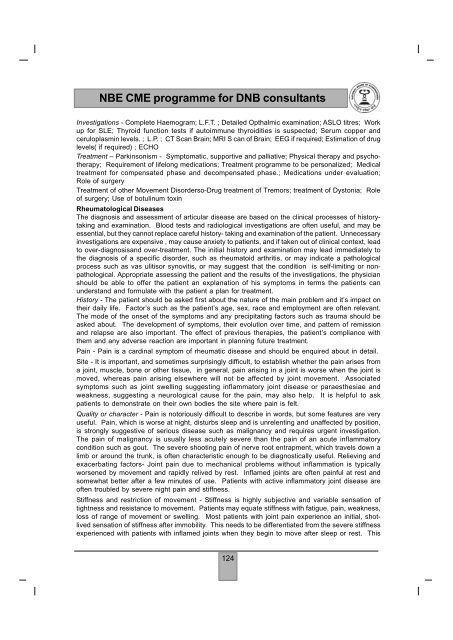NBE CME programme for DNB consultants - National Board Of ...
NBE CME programme for DNB consultants - National Board Of ...
NBE CME programme for DNB consultants - National Board Of ...
You also want an ePaper? Increase the reach of your titles
YUMPU automatically turns print PDFs into web optimized ePapers that Google loves.
<strong>NBE</strong> <strong>CME</strong> <strong>programme</strong> <strong>for</strong> <strong>DNB</strong> <strong>consultants</strong>Investigations - Complete Haemogram; L.F.T. ; Detailed Opthalmic examination; ASLO titres; Workup <strong>for</strong> SLE; Thyroid function tests if autoimmune thyroidities is suspected; Serum copper andceruloplasmin levels. ; L.P. ; CT Scan Brain; MRI S can of Brain; EEG if required; Estimation of druglevels( if required) ; ECHOTreatment – Parkinsonism - Symptomatic, supportive and palliative; Physical therapy and psychotherapy;Requirement of lifelong medications; Treatment <strong>programme</strong> to be personalized; Medicaltreatment <strong>for</strong> compensated phase and decompensated phase.; Medications under evaluation;Role of surgeryTreatment of other Movement Disorderso-Drug treatment of Tremors; treatment of Dystonia; Roleof surgery; Use of botulinum toxinRheumatological DiseasesThe diagnosis and assessment of articular disease are based on the clinical processes of historytakingand examination. Blood tests and radiological investigations are often useful, and may beessential, but they cannot replace careful history- taking and examination of the patient. Unnecessaryinvestigations are expensive , may cause anxiety to patients, and if taken out of clinical context, leadto over-diagnosisand over-treatment. The initial history and examination may lead immediately tothe diagnosis of a specific disorder, such as rheumatoid arthritis, or may indicate a pathologicalprocess such as vas ulitisor synovitis, or may suggest that the condition is self-limiting or nonpathological.Appropriate assessing the patient and the results of the investigations, the physicianshould be able to offer the patient an explanation of his symptoms in terms the patients canunderstand and <strong>for</strong>mulate with the patient a plan <strong>for</strong> treatment.History - The patient should be asked first about the nature of the main problem and it’s impact ontheir daily life. Factor’s such as the patient’s age, sex, race and employment are often relevant.The mode of the onset of the symptoms and any precipitating factors such as trauma should beasked about. The development of symptoms, their evolution over time, and pattern of remissionand relapse are also important. The effect of previous therapies, the patient’s compliance withthem and any adverse reaction are important in planning future treatment.Pain - Pain is a cardinal symptom of rheumatic disease and should be enquired about in detail.Site - It is important, and sometimes surprisingly difficult, to establish whether the pain arises froma joint, muscle, bone or other tissue, in general, pain arising in a joint is worse when the joint ismoved, whereas pain arising elsewhere will not be affected by joint movement. Associatedsymptoms such as joint swelling suggesting inflammatory joint disease or paraesthesiae andweakness, suggesting a neurological cause <strong>for</strong> the pain, may also help. It is helpful to askpatients to demonstrate on their own bodies the site where pain is felt.Quality or character - Pain is notoriously difficult to describe in words, but some features are veryuseful. Pain, which is worse at night, disturbs sleep and is unrelenting and unaffected by position,is strongly suggestive of serious disease such as malignancy and requires urgent investigation.The pain of malignancy is usually less acutely severe than the pain of an acute inflammatorycondition such as gout. The severe shooting pain of nerve root entrapment, which travels down alimb or around the trunk, is often characteristic enough to be diagnostically useful. Relieving andexacerbating factors- Joint pain due to mechanical problems without inflammation is typicallyworsened by movement and rapidly relived by rest. Inflamed joints are often painful at rest andsomewhat better after a few minutes of use. Patients with active inflammatory joint disease areoften troubled by severe night pain and stiffness.Stiffness and restriction of movement - Stiffness is highly subjective and variable sensation oftightness and resistance to movement. Patients may equate stiffness with fatigue, pain, weakness,loss of range of movement or swelling. Most patients with joint pain experience an initial, shotlivedsensation of stiffness after immobility. This needs to be differentiated from the severe stiffnessexperienced with patients with inflamed joints when they begin to move after sleep or rest. This124
















